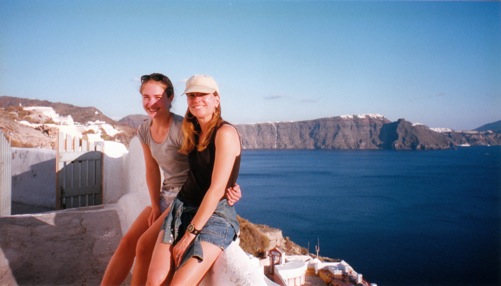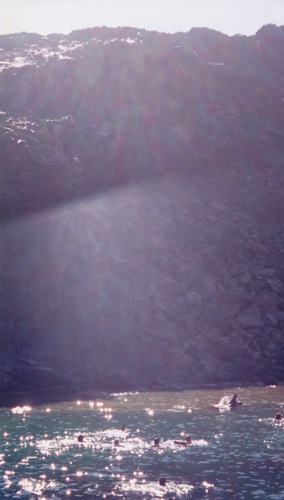Goddesses in the Dirt: Santorini - Tranquil Surface.....Fiery Underworld
Unearthing the Divine Feminine, one archetype at a time...
In the middle of the Mediterranean Sea, off the coast of Greece lies an island with an explosive history - literally. Called by many names, her latest is the most famous and recognized of them all: Santorini - a contraction of the name given her in the 13th century - Saint Irene or Santa Irini - named after a church dedicated to the saint in the small island village of Perissa.
Irene and Persephone have the Underworld in common: in the Catholic history of the saint it is said that Irene and her mother prayed in the catacombs of ancient Rome, often spending entire nights underground, praying for the souls of the departed martyrs. The Orthodox history of Irene states she was born a daughter of a prince and in her youth became a Christian. In her pious zeal she broke all the idols of her father, who ordered that she be trampled by horses as punishment. She remained unharmed but one of the horses reared up and killer her father instead. She endured many torments throughout her life but also worked many miracles through her faith in God. She died and was buried at the site of Ephesus in modern day Turkey in the 4th century A.D. Two days later her gravestone was found moved and her grave empty.
Santorini - or Thera as it is known in Greek - is one of the most photographed places on earth, its sheer beauty is both jaw-dropping and serene, as the name Irene - which is derived from the Greek Eirini, meaning peaceful - implies. The sheer cliffs rising straight from the sea are gorgeous, but the island's tranquility hides a devastating past: Santorini is actually a volcano that exploded in one of the earth's most powerful eruptions some 3500 years ago. At that time the Minoan civilization flourished on the island. Archaeologists discovered the site of Akrotiri in the 1960s, a city with houses, shops, staircases and pottery, along with fabulous frescoes depicting their daily life. Yet they found few skeletons, leading them to believe that the inhabitants fled due to powerful earthquakes that shook the island before the eruption. At the time the island had a ring-like shape, formed by the top of a submerged volcano. After the eruption, half of the island collapsed into the caldera, leaving behind the crescent moon shaped cliffs so often depicted in photographs.

I've been fortunate to visit this island on many occasions, the latest last summer. Every time I sense an energy about the place, almost a nervous energy, as the island is subject to mudslides, rockslides as well as earthquakes that continue to affect the region. But mostly it's due to the fact that the volcano is still active. On a recent trip, a friend told me she sensed the presence of Pele. Known as the "She Who Shapes the Sacred Land", I understood her as the Hawaiian goddess of volcanoes. In Hawaiian mythology, erupting volcanoes were thought to be Pele's way of showing anger, throwing molten lava at her many lovers whom she thought deceived her.
But Pele is not confined to just the volcanoes of the Hawaiian islands. She is definitely here, among the burnt cone that is still smoking (on which my daughter and I stood)


on the edge
I feel very lucky that Pele allows us to trespass into her world. Her friend Irene may keep things serene in these parts, but you never know when the goddess of fire is going to shake things up once again...
Images of Saint Irene and Pele from Google, all other photos courtesy of author
Irene and Persephone have the Underworld in common: in the Catholic history of the saint it is said that Irene and her mother prayed in the catacombs of ancient Rome, often spending entire nights underground, praying for the souls of the departed martyrs. The Orthodox history of Irene states she was born a daughter of a prince and in her youth became a Christian. In her pious zeal she broke all the idols of her father, who ordered that she be trampled by horses as punishment. She remained unharmed but one of the horses reared up and killer her father instead. She endured many torments throughout her life but also worked many miracles through her faith in God. She died and was buried at the site of Ephesus in modern day Turkey in the 4th century A.D. Two days later her gravestone was found moved and her grave empty.
Santorini - or Thera as it is known in Greek - is one of the most photographed places on earth, its sheer beauty is both jaw-dropping and serene, as the name Irene - which is derived from the Greek Eirini, meaning peaceful - implies. The sheer cliffs rising straight from the sea are gorgeous, but the island's tranquility hides a devastating past: Santorini is actually a volcano that exploded in one of the earth's most powerful eruptions some 3500 years ago. At that time the Minoan civilization flourished on the island. Archaeologists discovered the site of Akrotiri in the 1960s, a city with houses, shops, staircases and pottery, along with fabulous frescoes depicting their daily life. Yet they found few skeletons, leading them to believe that the inhabitants fled due to powerful earthquakes that shook the island before the eruption. At the time the island had a ring-like shape, formed by the top of a submerged volcano. After the eruption, half of the island collapsed into the caldera, leaving behind the crescent moon shaped cliffs so often depicted in photographs.

I've been fortunate to visit this island on many occasions, the latest last summer. Every time I sense an energy about the place, almost a nervous energy, as the island is subject to mudslides, rockslides as well as earthquakes that continue to affect the region. But mostly it's due to the fact that the volcano is still active. On a recent trip, a friend told me she sensed the presence of Pele. Known as the "She Who Shapes the Sacred Land", I understood her as the Hawaiian goddess of volcanoes. In Hawaiian mythology, erupting volcanoes were thought to be Pele's way of showing anger, throwing molten lava at her many lovers whom she thought deceived her.
But Pele is not confined to just the volcanoes of the Hawaiian islands. She is definitely here, among the burnt cone that is still smoking (on which my daughter and I stood)

the deep waters of the caldera heated by sulfur spewing into them from underground (in which we went swimming - it was really warm, even in November!)
and the sense that everywhere you go in this magical place

you are always
on the edge
Images of Saint Irene and Pele from Google, all other photos courtesy of author













